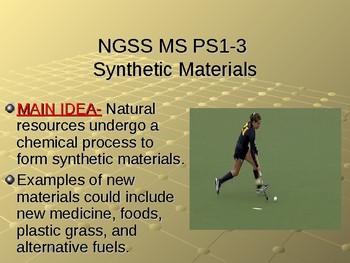NGSS MS PS1-3 Synthetic Materials PowerPoint
- PPT
Description
NGSS MS PS1-3 Synthetic Materials PowerPoint
MAIN IDEA- Natural resources undergo a chemical process to form synthetic materials.
Examples of new materials could include new medicine, foods, plastic grass, and alternative fuels. PS1.A: Structure and Properties of Matter
Each pure substance has characteristic physical and chemical properties (for any bulk quantity under given conditions) that can be used to identify it.
Ex.) Silver-Malleable, luster, conductive, melting point, nonflammable, etc.
PS1.B: Chemical Reactions
Substances react chemically in characteristic ways. In a chemical process, the atoms that make up the original substances are regrouped into different molecules, and these new substances have different properties from those of the reactants.
Synthetic-Something made via a chemical reaction.
Made by humans, does not exist in nature.
Synthetic materials-Materials that are made of synthesized polymers or small molecules.
The compounds used to make these materials come from petroleum chemicals or petrochemicals.
Polymer-A chemical compound that is made of small molecules that are arranged in a simple repeating structure to form a larger molecule.
Ex.) Plastic Wrap
Plastics do not degrade, so they are a great source of environmental pollution. In addition, most plastics are derived from crude oil, which is not renewable.
Nylon was the first synthetic fiber produced in mass. This was due to the need to replace Asian silk and hemp in parachutes during World War II.
At that time it was used to manufacture tires, tents, ponchos and other military supplies. It was even used to make paper money in the United States.
Polyester can be found in shirts, pants, jackets, hats, sheets, duvets, cushions, cushions, upholstered furniture and towels. Industrial polyester is used to reinforce tires, safety belts, and to reinforce highly absorbent plastics.
Carbon Fiber is a reinforced plastic, strong and light. Carbon fiber can be costly to manufacture, but it is widely used in the automotive, aerospace, civil engineering, sports and other technical applications industries.
It is rigid but at the same time moldable and has good resistance to high temperatures.
Kevlar is a very strong plastic. It has very sought after properties because it is made of fibers that are strongly pressed with each other.
Kevlar is an excellent anti-ballistic material, since it is difficult for a bullet or a knife to pass through the fibers. It is stronger than steel, like a modern armor, but lighter and more flexible.
The U.S. Energy Information Administration says that “plastics are made from liquid petroleum gases (LPG), natural gas liquids (NGL), and natural gas. LPG are by-products of petroleum refining and NGL are removed from natural gas before it enters transmission pipelines.”
Extraction of crude oil and gases is one of the most contentious environmental issues of our modern, growing and globalizing world.
Synthetic materials are created by using natural resources. These materials are created in labs by using chemical reactions.
Ex.) Burning of limestone for the production of concrete.
Chemical Reaction-a process in which one or more substances, the reactants, are converted to one or more different substances, the products.
A chemical reaction rearranges the constituent atoms of the reactants to create different substances as products.
Chemical Formula-contains atomic symbols and subscripts to show the elements and the number of each atom.
Ex.) H20 for water or C12H22O11 for sugar
Strength a material shows when it is pulled.
Natural fibers absorb water quite efficiently whereas synthetic fibers do not.
Most synthetic polymers are heat sensitive. On being heated, they melt, and at higher temperatures they burn.
Synthetic polymers are generally bad conductors of heat, i.e., they have low thermal conductivity.
Synthetic polymers are generally insulators, i.e., bad conductors of electricity.
Ex.) Styrofoam
Modern polymers are very useful. For instance, they can be used as:
new packaging materials
waterproof coatings for fabrics ( for outdoor clothing)
fillings for teeth
dressings for cuts
hydrogels (for soft contact lenses and disposable liners)
smart materials (shape memory polymers for shrink-wrap packaging)
Synthetics are cheaper and easier to produce in large quantities. This may be good for the bottom line, but it is damaging the environment in a big way—contributing an overwhelming amount of chemicals, waste and carbon emissions.
Are the benefits worth these dire consequences?
The best way to protect our environment and the health of our global community, is to lean towards natural fibers or synthetics that are produced more responsibly.
To build a sustainable and more eco-friendly wardrobe or product line, avoid synthetic materials like polyester or nylon as much as possible.
Summary
Synthetic materials, via chemical reactions, come from natural resources.
Natural resources undergo a chemical process to form the synthetic material.
Examples of new materials could include new medicine, foods, and alternative fuels.
Can be edited for older or younger learners. Check out my NGSS MS PS1-3 Synthetic Materials worksheet to check for understanding.





